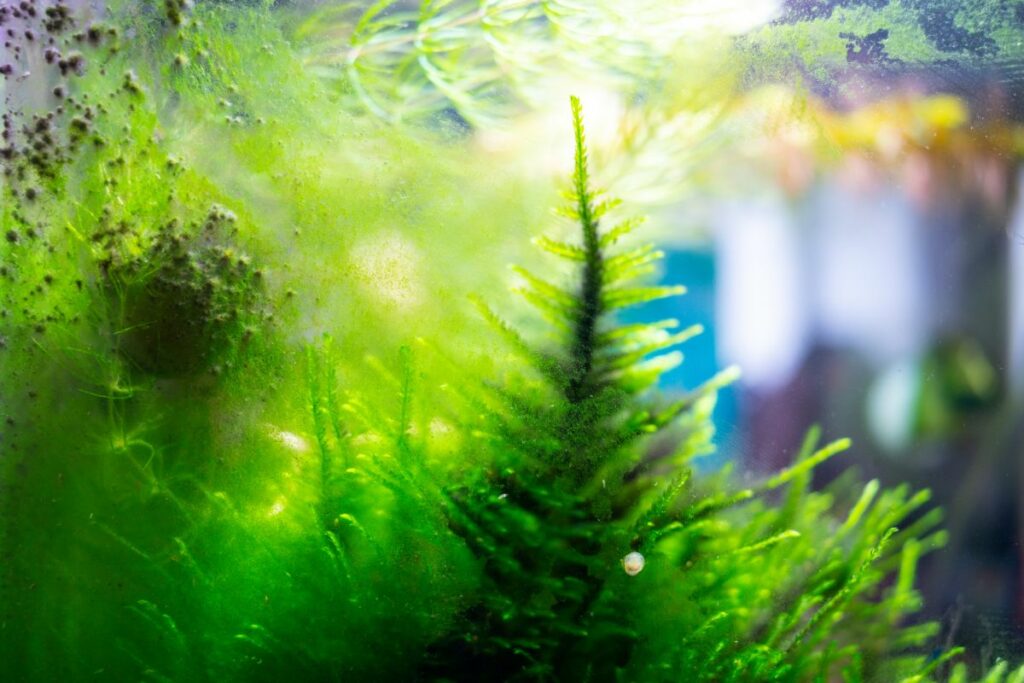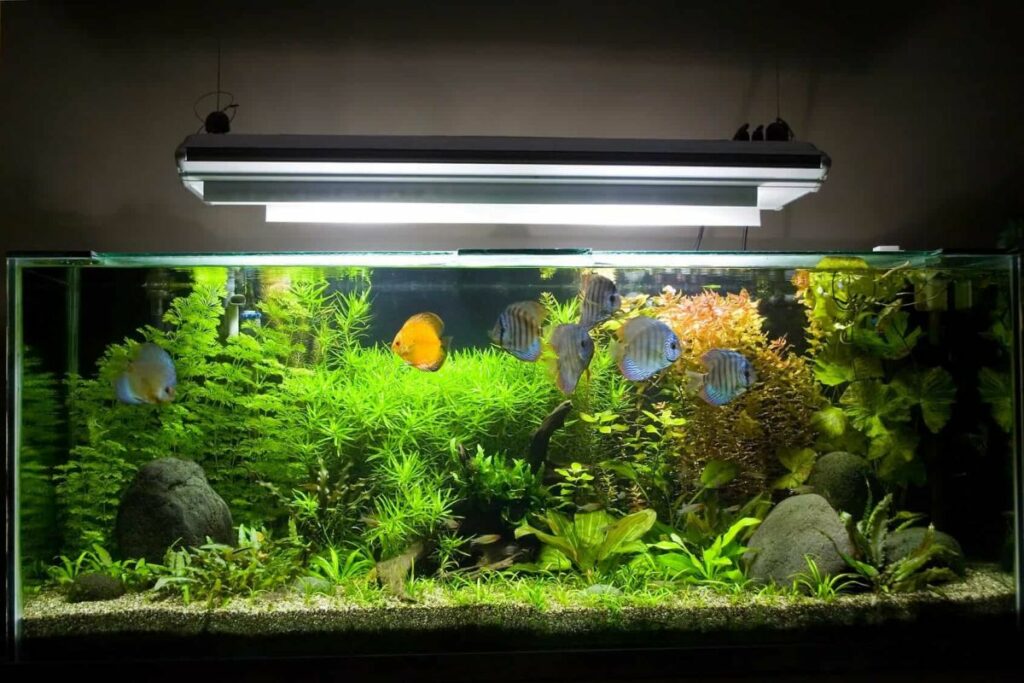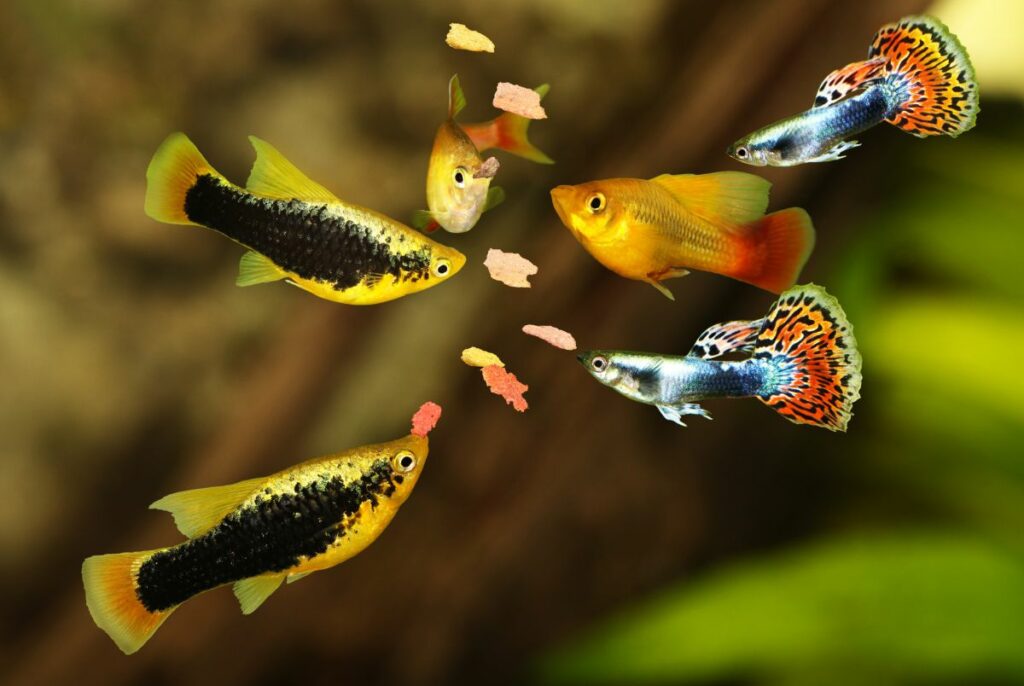Green aquarium water happens when blooms of single-celled algae become visible. There are thousands of species that exist in freshwater and saltwater environments all over the world. Green water in fish tanks won’t harm your pets but it is ugly. The algae are difficult to remove for good since even a few remaining cells will turn your tank green in a few days.

What Causes Green Water in Fish Tanks?
Algae cells are always around in small amounts. They are kept in balance through competition with bacteria, live plants, and your aquarium maintenance schedule. Greenish water in aquariums arises when that balance is thrown off in favor of the algae somehow.
Instead of single cells you now have a cloud that turns the water a murky yellow or green color. The tank looks like pea soup and the algae will reduce incoming light to live plants. When you have green aquarium water you often see other types of algae take hold. Green hair algae, green spot algae, and black beard algae thrive in the same conditions.
Why Does My Fish Tank Keep Turning Green?
Green aquarium water is difficult to fix for good. Performing a water change will clear your water. But there will be algae cells left over and they will return so long as conditions favor their growth. You must address these imbalances to remove it for good:
- Excess Nutrient Levels: algae need food like all organisms. Like plants, they need nitrogen and phosphorus most of all. Nitrogen comes from ammonia, nitrite, and nitrate in your aquarium water. Bacteria cause the decay of protein sources like fish poop and leftover food. Fish also release ammonia as waste through their gills. Phosphates from fish food and poop are where phosphorus comes from. Overstocking an aquarium also increases nutrient levels. The more fish you have, the more they eat. And the more they eat, the more they poop.
- Too Much Light: algae are photosynthetic organisms and require light to make food. Fish hobbyists often leave their lights running at full power for longer than required. An aquarium that gets direct sunlight will have green water problems, not to mention added heat that may even kill your fish.
Is Green Water Bad for Fish?
Green aquarium water won’t harm your pets. Algae are a natural part of the aquatic ecosystem, providing free oxygen and removing carbon dioxide from the water. Oceanic green water algae create around 70% of the oxygen we breathe via photosynthesis. They also reduce incoming light, so fish feel safer out in the open.
Some aquatic organisms even eat green water algae. In freshwater tanks, tiny baby fish fry like those of betta fish will eat them for the first few weeks of their lives. Freshwater clams also feed on it.
Green aquarium water does reduce oxygen levels at night, however. All photosynthetic organisms make oxygen but only during the day. At night they reverse the process, consuming oxygen and releasing CO2. If your aquarium aeration levels aren’t sufficient, green water algae may produce enough CO2 to suffocate your fish.
How to Clear Green Aquarium Water
Green aquarium water requires a multi-pronged approach to correct unless you prefer using a UV sterilizer.
Use a UV Sterilizer

UV sterilizers are the most effective way to get rid of green water in a fish tank. They work by sucking in water and blasting it with ultraviolet light. These wavelengths are fatal to microbial life so the water is purified upon exiting the chamber.
A UV sterilizer will clear your water in two to four days, depending on the size of your fish tank. They are also the most effective way to clear green pond water since direct sun in the outdoors is so good at growing algae.
Once your aquarium water is clear, you may still need to reduce feedings to control nitrogen and phosphorus levels. Otherwise green water algae could return again.
Perform Water Changes
Doing water changes has a twofold effect on green water algae. First, you are physically removing algae cells. Second, you’re exporting nutrients that would otherwise feed more algae growth.
I don’t recommend removing more than 50% of your aquarium water at a time, however. Large water changes cause shifts in parameters that may cause fish stress. The aquarium’s pH will rise if your tap water is hard and alkaline. Temperature changes larger than 5 degrees ℉ are fatal to sensitive species.
Reduce Light Levels
Controlling how much light is hitting your fish tank is an important step to getting green aquarium water under control. If you aren’t growing live plants then try a total shutdown of your fish tank lights for a week. Your fish will still be able to navigate, eat, and regulate their sleep/waking cycle with ambient room light.
Another solution is to use a light timer. These allow any live plants you have to grow as normal. I recommend 4 hours in the morning, followed by a break of a few hours starting just before noon. Then the lights can come back on for 4 more hours in the afternoon and early evening. Before shutting down at night.
Don’t Overfeed Your Fish

Learn how much to feed your fish without leaving leftovers. Feedings should be light but frequent. 2 or 3 feedings per day is better than one heavy feeding where flakes get left behind. Skipping meals every so often is also as good for fish as it is for us humans.
If you overfeed by accident, get your siphon hose and do a tiny water change, sucking up the loose debris. Don’t let it remain at the bottom unless you have snails, corydoras catfish, ghost shrimp, or other bottom feeders that will eat it.
Add a Diatomaceous Earth Filter Pad
Diatom filters are satchels filled with food grade diatomaceous earth. Diatoms are photosynthetic microorganisms, many of which are related to green water algae. Except they create beautiful silica skeletons during their lives.
When they die, the skeletons remain, forming a glass powder that is useful for polishing, garden pest control, and as an aquarium microfiltration system.
Since diatoms are microscopic, they are tiny enough to catch green water algae as water passes through the pad. They will clog fast, however. So you’ll need to change out the pads often if you have a heavy algae problem.
Conclusion
Green aquarium water is persistent and hard to treat once you have it. Light levels, nutrient cycles, and water changes are the best way to get it under control, however. Filtration technology like diatomaceous earth and UV sterilizers are even more effective ways to turn your water clear.

